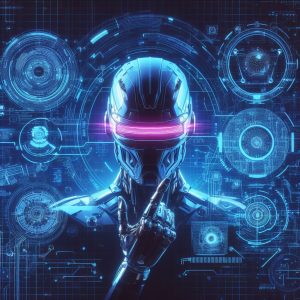Contents
Unlocking the Eyes of AI: What is Computer Vision in AI?
Computer vision is a transformative force within artificial intelligence, teaching computers to see and comprehend our world with striking clarity. It underpins many of today’s groundbreaking AI applications, from autonomous vehicles cruising our roadways to advanced medical diagnostics that save lives. “What is computer vision in AI?” Simply put, it’s the technology that enables machines to interpret visual information from the world around them, much like human vision translates light into comprehensible images. As we stand on the cusp of future technological revolutions, the role of computer vision is undeniable—it will continue to enhance and innovate, pushing the boundaries of what machines can do. This field doesn’t just equip machines with the power to perceive—it’s setting the stage for a future where AI can interact with our environment in full visual context, unlocking potential we’ve only just begun to explore.
Computer vision is like giving eyes to the brain of a computer, but it’s about more than just capturing what is visible. It’s about translating visuals into context, with the aim of making decisions based on that information. Think of how a self-driving car needs to differentiate between a pedestrian and a street sign, or how your smartphone camera detects a face to focus on for a perfect picture. This technology has become a game-changer in industries ranging from healthcare to retail to automotive, transforming the way machines interact with the human world.
Historical Background
Computer vision’s journey began in the 1950s when scientists first dreamt of enabling machines to see. Early efforts were modest; the first algorithms could only recognize simple patterns and shapes. But the seeds were planted, and through the decades, this pioneering work set the stage for a series of breakthroughs.
Key milestones arrived with the introduction of more sophisticated algorithms in the 1980s and 1990s. These could tackle more complex tasks, like identifying and tracking moving objects. The field really hit its stride with the advent of powerful digital cameras and increases in computing power. Suddenly, computers could process images and learn from them at unprecedented speeds.
But it was the coupling with artificial intelligence that truly ignited computer vision’s explosive growth. AI provided the learning mechanisms, like neural networks, which mimicked the way the human brain processes visual information. With AI, computer vision systems could not only see but also understand and interpret what they saw, leading to today’s smart technology that can recognize faces, diagnose diseases from medical imagery, and even interpret emotions. This symbiosis with AI has ensured that as AI evolves, so too does the capability of computer vision, making it one of the most dynamic and transformative technologies of our time.
Core Concepts in Computer Vision
Computer vision is a fascinating slice of artificial intelligence that allows computers to extract, process, and understand visual data from the world. It starts with image acquisition, where cameras, sensors, or other imaging devices capture visual information, much like our eyes do. This data could be a photo of your cat, a live video feed from a traffic camera, or even a 3D model from medical imaging equipment.
Once an image is captured, it’s time for some digital wizardry known as image processing. Here, the computer tweaks and adjusts the raw images—sharpening details, enhancing contrasts, or filtering out noise—to make the subsequent steps more accurate. It’s like cleaning your glasses to see better.
Next up is object recognition, where AI tries to identify and label the objects in an image. It could be anything from recognizing your friend’s face in a photo to detecting a stop sign on the road. This is closely tied to pattern detection and classification, where the system looks for specific patterns that it knows correspond to particular objects or features.
Underpinning these steps is machine learning, especially neural networks, which are algorithms modeled after the human brain. They learn from vast amounts of data, picking out intricate patterns that are too complex for a human to program manually. By training on thousands, or even millions, of images, these neural networks enable computer vision systems to not only see but also understand and interact with the visual world in a way that is increasingly sophisticated and human-like.
How Computer Vision Works
At its core, computer vision is all about enabling computers to make sense of visual data, just like we do with our eyes. It begins with interpreting image data — breaking down photos or videos into pixels and then analyzing these pixels to identify patterns and features. Algorithms play a crucial role here; they’re the set of rules or instructions that guide the computer on what to look for in the image. These algorithms are part of more complex models that have been trained, usually through machine learning, to recognize various objects and elements in an image.
Consider a basic computer vision workflow like a barcode scanner in a supermarket. The scanner captures the image of the barcode, which is then processed to highlight the bars and spaces. An algorithm interprets the sequence of bars and spaces, matches this pattern with product information from a database, and voila — the price pops up on the screen. That’s computer vision in action: capturing, processing, and understanding images to perform a task.
Computer Vision Techniques
Computer vision isn’t just one technique but a whole toolbox that helps machines see and understand. Convolutional Neural Networks (CNNs) are one of the heavy lifters here. Think of them as specialized brain cells in a computer that are really good at spotting patterns in images, like distinguishing cats from dogs in your photo album. They work by filtering through the image and honing in on the important visual features.
Another clever trick in the computer vision toolkit is edge detection. It’s a bit like sketching out the outline of shapes in a drawing. By finding the edges, computers can figure out where one object ends and another begins, which is super helpful for understanding complex scenes.
Then there’s feature matching and object tracking. Imagine you’re watching a movie and you want to follow your favorite actor through a crowd. Computer vision does something similar; it picks out unique features and keeps an eye on them, tracking their movement through video frames.
Lastly, we’ve got 3D vision and depth perception. This is where the computer figures out how far away things are and how they relate to each other in space, giving it a much more realistic understanding of the scene. It’s like the difference between a flat picture and a sculpture you can walk around and view from all angles. Together, these techniques empower computers to interpret the visual world with incredible depth and detail.
Applications of Computer Vision
Computer vision is a technological marvel that’s found its way into a plethora of applications, fundamentally changing numerous industries. One of the most talked-about applications is in autonomous vehicles. Here, computer vision systems constantly analyze visual data to navigate roads, identify obstacles, and ensure passenger safety—all without a human at the wheel.
Another area where computer vision has made a significant impact is security. Facial recognition technology uses it to pick out individual faces in a crowd, helping to bolster security systems and enhance surveillance capabilities.
In the healthcare sector, medical imaging and diagnostics have been transformed by computer vision. Machines can now read X-rays and MRI scans, spotting diseases like cancer early on by identifying minute details that might escape the human eye.
Industrial automation is another frontier. Computer vision guides robots in manufacturing plants to ensure precision and quality control. It can spot defects on a production line in real time, preventing faulty products from ever reaching the customer.
Finally, augmented reality (AR) and entertainment have become playgrounds for computer vision. From Snapchat filters that track and modify your face to AR games that integrate virtual elements into our real-world environment, computer vision is creating immersive and interactive experiences that were the stuff of science fiction just a few years ago.
By bridging the gap between digital information and the physical world, computer vision is not just an exciting AI technology but a transformative force across the global economy.
Challenges in Computer Vision
Computer vision might seem like magic, but it’s not without its hurdles. One of the biggest challenges is the sheer variety and messiness of the visual data it has to understand. Unlike neatly organized databases, the real world is chaotic. A computer vision system must make sense of different objects, settings, and angles — all of which can vary wildly from one image to the next.
Then there’s the issue of lighting and environmental changes. Just like how a sudden glare can momentarily blind us, a computer vision system can struggle if the light changes abruptly or if shadows cast over important features in an image. These systems need to be robust enough to handle the whims of Mother Nature or the flick of a light switch.
Real-time processing is another significant challenge. For applications like self-driving cars or video surveillance, the system must interpret and act on visual data almost instantly. There’s no time for buffering when safety is on the line.
Lastly, as computer vision technology spreads, it brings with it a basket of privacy concerns and ethical issues. As these systems become more prevalent in public and private spaces, questions about surveillance, consent, and data security become increasingly important. Balancing the benefits of computer vision with respect for individual privacy is a tightrope walk that society is still figuring out how to navigate.
The Future of Computer Vision
As we peer into the future of AI and computer vision in AI, it’s gearing up to be an even more integral part of our digital lives. Its fusion with other AI technologies, like natural language processing and predictive analytics, hints at a future where machines will not only see but also understand and anticipate our needs with greater context. This integration has the potential to breed new applications across diverse industries, from smarter home assistants that know when you’re out of milk, to agricultural drones that monitor crop health from the sky.
Furthermore, the horizon glimmers with the promise of computer vision systems that learn and adapt over time. Rather than being static, these systems will evolve with each interaction, growing more precise and efficient. They’ll adjust to new patterns in real-time, making technologies such as autonomous vehicles and personalized shopping experiences more robust and reliable. With every snapshot and scan, computer vision is set to become more entwined with our everyday tasks, redefining convenience and functionality in an ever-changing technological landscape.
Final Thoughts
Computer vision stands as one of the most remarkable and rapidly advancing domains in artificial intelligence. By granting machines the ability to discern and interpret the visual world, it has catalyzed innovations that once bordered on the realm of science fiction. From self-driving cars navigating city streets to medical diagnostic systems that detect diseases with superhuman accuracy, computer vision is reshaping our interaction with technology.
As we contemplate the future, it’s clear that computer vision will continue to be a linchpin in the evolution of AI, influencing every new technological frontier. The implications of AI stretch far and wide, promising enhancements in efficiency, safety, and convenience across all sectors of society. So, if you’ve been asking, “What is computer vision in AI?”, it’s the groundbreaking force that’s integrating sight into machines, allowing them to analyze and interact with the visual world in ways we are only beginning to comprehend. Computer vision doesn’t just represent a technological leap forward; it’s a foundational tool that will empower future technologies with sight, transforming how we live, work, and play. Its ongoing journey promises to be as transformative as the invention of the camera itself, if not more so, as it continues to intertwine the digital and physical worlds in increasingly sophisticated ways.
Key Takeaways
- Revolutionizing Technology with Sight: Computer vision is a critical facet of AI that gives machines the ability to interpret and understand the visual world, leading to groundbreaking applications such as autonomous vehicles, facial recognition for security, medical diagnostics, and more. It goes beyond mere image capture; it involves the nuanced interpretation and contextualization of visual data for decision-making, much like human sight.
- Evolving Through Challenges: Despite its advances, computer vision faces significant challenges like handling unstructured data, adjusting to varying lighting conditions, meeting real-time processing demands, and navigating privacy and ethical concerns. Addressing these issues is crucial for advancing the reliability and acceptance of computer vision applications.
- Shaping the Future: The integration of computer vision with other AI technologies is paving the way for innovative applications and industries. With the potential for continuous learning and adaptive systems, computer vision is set to further revolutionize our interaction with technology, enhancing everyday life with smart, visual-context aware AI systems.


